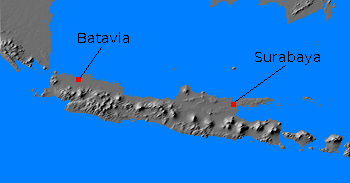![]() The Pacific War Online Encyclopedia
The Pacific War Online Encyclopedia
|
| Previous: Jaunpur | Table of Contents | Next: Java Sea |

Java was the administrative and
economic center of the Netherlands
East Indies and virtually a
second homeland to the Dutch.
It is a
large island, about 661 miles (1063 km) long and 200 miles (320 km)
wide, with a
chain of
active volcanoes running east to west. These average 7000' to 11,000'
(2100 to 3400 meters) tall, the tallest point being Mount
Semeru at 12,060 feet (3676 meters). Of the 44 volcanoes on the island,
twenty have been active during historical times. Rainfall averages 90
inches (230
cm) per year, but can reach 400 inches (1000 cm) on some of the
north-facing mountain slopes. The northwest monsoon is from November to
March and the dry season from June to October. Temperatures stay within
the range 70-90F (20-30C) year-round. The mountains are jungle-clad while the western part of
the island is covered by vast bamboo forests. There are almost no
coastal swamps, and the more level terrain
is heavily cultivated and highly productive.
The island was inhabited by early humans as long as half a million years ago and had been settled by Indians by the 7th century. By the 13th century Islam had been introduced, and the island was dominated by the Muslim state of Mataram from the 16th century onwards. The Portuguese were the first Europeans to explore this area, but the Dutch established a post at Batavia in 1619 under the auspices of the United East India Company (Vereenigde Ooslindische Compagnie) and gradually absorbed the native kingdoms. The VOC governed brutally and shortsightedly but was abolished in 1798 and the island came under direct control of the Dutch government. Dutch rule remained heavy handed until the Diponegoro uprising of 1825-1830, after which a more humane approach was attempted. Slavery was abolished and the infrastructure improved. However, for the most part, Dutch administration from 1830 to 1940 went from brutal to ham-fisted, and a strong nationalist movement was organized in 1927 under Sukarno and was active when the Japanese invaded in February 1942.
With a total population of at least 41 million in 1945, of whom 200,000 were Europeans and 600,000 Chinese, Java had a much higher population density than any other island of the Netherlands East Indies, and it had valuable resources. Batavia was the most important port in the area. The rich volcanic soil produced rice, rubber, sugar, quinine, and other crops in quantity, and there was a valuable oil field near Surabaya that produced a million barrels in 1940. This oil was particularly rich in light fractions, and the Dutch build two refineries to exploit it.
The island had fairly well developed infrastructure, with a good road network and some 3437 miles (5531 km) of railroad. There were 876 telegraph stations and some telephone and cable systems. There were twelve cities on Java with populations in excess of 50,000 persons.
There were three Dutch military departments on
Java that were mobilized as divisions
when war broke out, but all were grossly understrength. I.
Division was located in west Java, II.
Division in central Java, and III.
Division in east Java. Total manpower was about 9000 Dutch regular
troops, 126,000 native
troops (of whom 40,000 were militia)
and 17,000 Dutch volunteer militia. These were enforced by a small
number of British, Australian, and American units after war broke
out. Of the Allied units, the most significant was the British BLACKFORCE, named
for its brigadier, which was positioned between Batavia and Bandung.
Java was the ultimate objective of Japan's Strike South, and its conquest was carefully planned and executed. From their bases in Formosa, French Indochina, and the Palaus, Japanese forces proceeded in a series of leaps from airfield to airfield, each leap given air cover from the airfields seized in the previous leap. Thus, Japanese forces from the Palaus first seized Davao with carrier air support, then advanced successively to Menado (11 January 1941), Kendari (24 January), Makassar (9 February), and Bali (19 February) to constitute the eastern prong of a pincers assault. The western prong advanced from Kuching (23 December 1941) to Palembang (13 February 1942.) In the meanwhile, another force had leapfrogged from Jolo to Tarakan (10 January) to Balikpapan (24 January). Balikpapan had an airfield within striking distance of Surabaya, and on 3 February the Allied air units in that area were annihilated by the Zeros of Tainan Air Group in a tremendous air battle.
With the destruction of the Allied naval squadron at the Battle of the Java Sea, Java was doomed. 2 Division with 16 Army headquarters (Imamura) landed at Merak and Banten in the west, 230 Regiment landed at Eretan Wetan (108.086E 6.329S) in the center, and 146 Regiment, followed by most of 48 Division, landed at Kragan west of Surabaya. The Japanese rapidly fanned out across the island. Counterattacks by BLACKFORCE in the west on 1 March and I. Division to the east on 2 March allowed the bulk of the Dutch troops to escape from Batavia, which fell on 5 March. With the capture of Tjilatjap by 230 Regiment on 7 March the situation became hopeless. The island was surrendered to the Japanese on 8 March 1942, and remained in Japanese hands for the remainder of the war.
References
The Pacific War Online Encyclopedia © 2006-2007, 2009-2010 by Kent G. Budge. Index